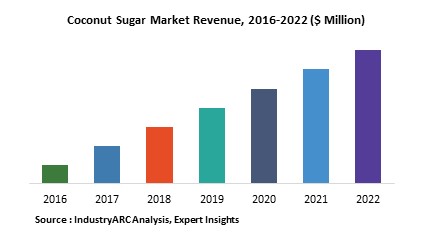Global Coconut Sugar Market Outlook
According to WHO, worldwide obesity has nearly tripled since 1975. Additionally, in 2016, more than 1.9 billion adults were overweight out of which over 650 million were obese. Now, this has become a major concern in the world which majorly attributes to the consumption of sugar that is responsible for raising insulin levels, subsequently leading to obesity. While the aforementioned data is disquieting, it’s a flourishing factor leading to the coconut sugar market growth that already had a global market size of $1.2 billion to $1.7 billion as of 2018 according to IndustryARC’s business intelligence report. Furthermore, the analyst projects that the coconut sugar market will grow at a remarkable CAGR of 5% to 6% during the forecast period of 2019-2025.
Coconut sugar is a healthy sugar produced from the sap of the flower bud stem of the coconut palm. It is also known as coconut palm sugar, coco sugar, coco sap sugar, or coconut blossom sugar. Coconut sugar is healthier than the common refined sugar as it has a low glycemic index, better electrolytes, and less fructose which causes multiple health issues. Due to this advantage, it is replacing refined sugar, leading to a constant rise in the global coconut sugar market revenue.
Coconut Sugar Market Trends – Disruption and an Analysis of Driving Factors Influencing the Market
Health Concerns Coupled with Awareness Widening the Coconut Sugar Marketplace –
According to a periodic survey by WHO, the number of people with diabetes was 108 million in 1980, and the figure catapulted to 422 million in 2014. Furthermore, the total number of deaths caused by diabetes in 2016 was 1.6 million, and the agonizing figure highly attributes to the consumption of refined sugar which has a high glycemic index. Moreover, cardiovascular diseases are number 1 cause of deaths in the world that had caused 17.9 million deaths in 2016, according to a 2017 report by WHO.
Now, the easily accessible Internet across the globe is creating health awareness among a remarkable fraction of the population. As larger masses become aware of the ill-effects of processed white sugar, increasing number of them are opting for healthier products, which is stroking the coconut sugar market by many-folds.
Even though coconut sugar is more expensive than the refined one, the people belonging to elite strata of society are willing to spend on it for a healthier life. So, the coconut sugar market is gaining grounds in developed and some parts of developing countries.
The coconut sugar has maximum application in food and beverages sector as it is used in bakery products, confectionary, food seasoning, juices, and tea. According to the estimations by the IndustryARC’s analyst, the application CAGR will be 5% to 6% in the sector.

Anti-aging Quality of Coconut Sugar: A Broad Spectrum of Target Market
Coconut sugar has amino acids which play an important role in the production of collagen within the skin which makes it an excellent anti-aging ingredient. Now, according to the predictions by the United Nations, the global population of people over 60 years of age was 962 million in 2017. Furthermore, the organization predicts that the population will be double in 2050 as compared to that in 2015. This means that a horde of people will face issues regarding their skins that attributes to aging during the forecast period of 2019-2025. The companies producing coconut sugar will be leveraging this and also the fact that the proliferating urbanization has led to a growth of disposable income. So, people around 40-50 years of age are more likely to use coconut sugar as a skincare product.
Coconut Sugar Market Share – A Regional Analysis
The leading region in the production will be APAC with a coconut sugar market share of 85%-90%. This chiefly attributes to the prevalence of coconut trees in many APAC countries such as India, Indonesia, and the Philippines to name a few. Even though there was a concern raised by Food and Agricultural Organization in 2013 about the aging of coconut trees in APAC, prompt actions were taken to rehabilitate the sector so that each of these countries keeps producing the usual figure of over 15 billion coconuts per year.
On the other hand, the demand for coconut products including coco sugar is rising in the European countries, especially in the food and beverages sector. This is mainly because the region is moving towards organic food products. So, coconut sugar market is also expected to witness growth in Europe.
Leading Players in the Coconut Sugar Market Leveraging the Demand –
Some of the market leaders in coconut sugar manufacturing are Cook Organic Foods LLP, Activa Enterprises Ventures Inc., and American Key Food Products. These key players are leveraging the demand for organic food in the U.S. and European countries.
Barry Callebaut which is the world’s leading manufacturer of chocolate and cocoa products is using coconut sugar to revive its organic chocolate sales. The company made the move to make their chocolate healthier and grab the attention of target customers by including coconut sugar which says volumes about the demand for the same.
The health issues pertaining to obesity and cardiovascular diseases are growing day by day. Moreover, the world is inclining towards organic food such as coconut sugar. The growing population of middle-aged and old people that are prospective customers of coconut sugar for skincare and consistent growth of disposable income has become the influencing factors of the thriving coconut sugar market. This is significantly backed by the consistent production of coconuts in the APAC region in the coming years; and so, it is discernible that coconut sugar market will be booming during the forecast period of 2019-2025.
"We also publish more than 100 reports every month in “Food and Beverage”, Go through the Domain if there are any other areas for which you would like to get a market research study."










Comments (0)
Post a Comment